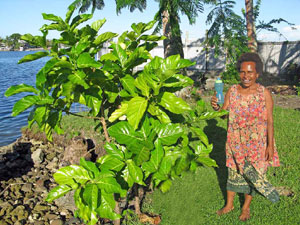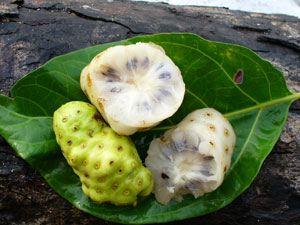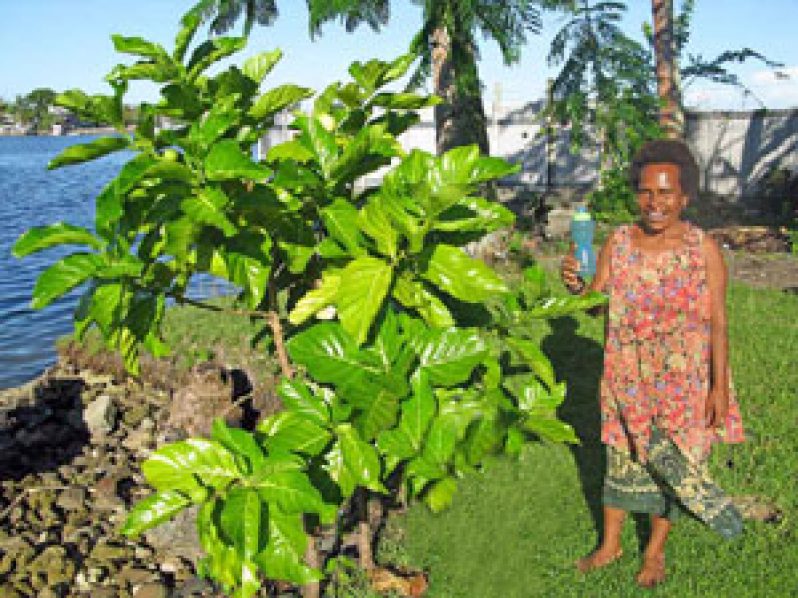IF anyone in Guyana speaks to you about ‘the painkiller bush’, listeners of other climes may understand that person to be referring to the Indian mulberry tree, also known as the Great Morinda tree, or the Nunaakai (Tamil Nadu, India) tree, the Dog Dumpling (Barbados) Tree, Mengkudu (Indonesia and Malaysia), Apatot (Philippines), Kumudu (Bali), Pace (Java), or the Beach Mulberry or Cheese-fruit Tree.
 The tree is scientifically named the Morinda citrifolia, but is popularly called the Noni Tree. It belongs to the coffee family, Rubiaceae.
The tree is scientifically named the Morinda citrifolia, but is popularly called the Noni Tree. It belongs to the coffee family, Rubiaceae.
The Noni Tree grows in shady forests. It can grow up to 9 metres (30 ft) tall, and has large, simple, dark green, shiny and deeply veined leaves. It bears flowers and fruits all year round. The fruit is a multiple fruit that has a pungent odour when ripening, and is hence also known as cheese fruit or even vomit fruit.
Oval in shape, it reaches a length of 10–18 centimetres (3.9 – 7.1 in) in size, and resembles a soursop or monkey apple; is green; and as it ripens, becomes yellow, then turns white. It has dark spots on the skin, and mostly a bunch of seeds underneath.
Native to the Pacific Islands, the Noni Tree is common along Guyana’s coast, and there are several growing in the vicinity of the Georgetown seawall. The tree has achieved worldwide fame as a source of a wide range of health benefits.
In the Pacific Islands and in Polynesian culture, the green fruit, leaves and root/rhizomes have traditionally been used to treat menstrual cramps, bowel irregularities, diabetes, liver diseases, and urinary tract infections.
In Guyana, many users swear by the usefulness of the juice of the fruit as an alternative medicine for a variety of ailments, even though the local Analyst Food and Drug Department has cautioned against its use without the approval of a physician.
 Many Guyanese, like many people worldwide, assert that Noni Juice, taken in its pure form, has helped conditions such as Hepatitis `C’, hernia, migraine, removal of moles and warts, psoriasis, rheumatoid arthritis, sinus infections, gastric ulcers, menstrual cramps, and pre-menopausal symptoms.
Many Guyanese, like many people worldwide, assert that Noni Juice, taken in its pure form, has helped conditions such as Hepatitis `C’, hernia, migraine, removal of moles and warts, psoriasis, rheumatoid arthritis, sinus infections, gastric ulcers, menstrual cramps, and pre-menopausal symptoms.
Noni Juice, they say, also relieves burns, skin irritations, skin infections, and insect bites; strengthens the immune system; facilitates good blood circulation; and contributes to emotional wellness, among other benefits.
One true believer says that she always keeps a bottle of Noni Juice in her refrigerator, and takes an ounce or two every day for about three months or so, then stops and starts again.
No corroboration
Some time ago, the Food and Drug Department issued a caution to the Guyanese public that it has not encountered authoritative scientific studies on the Noni fruit that can corroborate the various medicinal properties accredited to it.
The Department advised that it had not uncovered toxicology data that would warrant restricting the fruit’s use as a herbal preparation, but added that a major concern of some local preparations was their lack of purity, and the concentration of therapeutic constituents that do not allow for rational and prescribed dosage.
The Department advised all persons using herbal remedies, such as the Noni Juice treatment, to consult with their physician. As a further precaution, the Department advised that herbal preparations such as the Noni fruit juice should not be taken in conjunction with conventional medicines.




.png)









